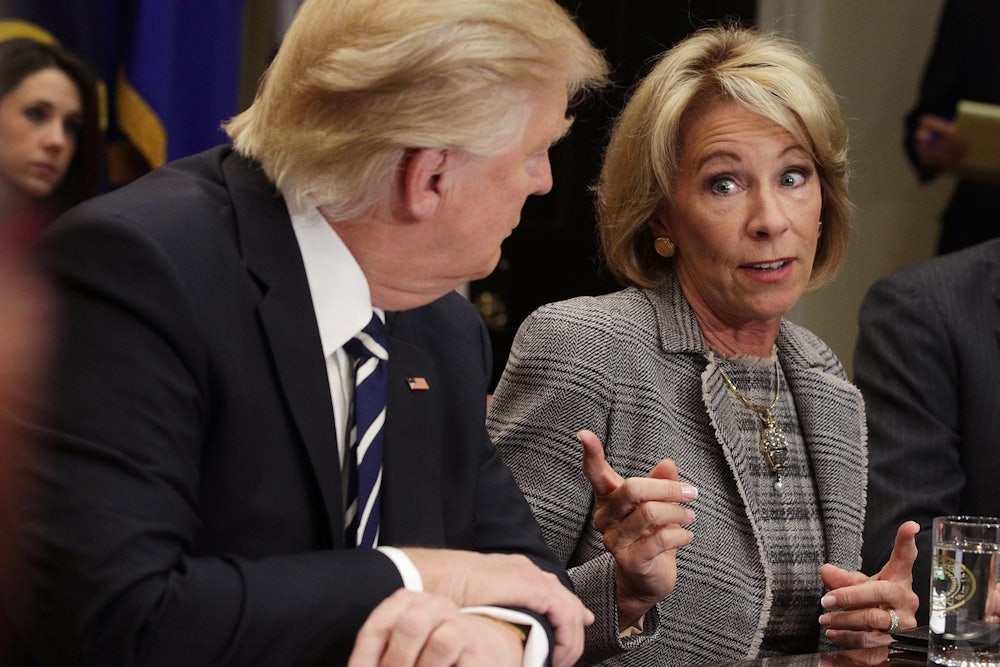“Students should not be asked to pay more on their loans than they can afford. And the debt should not be an albatross around their necks for the rest of their lives. It’s no good, it’s not fair.” One can imagine Elizabeth Warren or Bernie Sanders saying those words, but they actually came out of the mouth of Donald Trump during a speech in Ohio a month before the 2016 election.
It’s been completely forgotten today, but Trump’s platform included a decent student loan plan. Calling the debt burden a “crisis,” he vowed to cap loan repayments at 12.5 percent of a borrower’s income, and to completely forgive the balance if a borrower made payments for 15 years. This would be more generous than current income-based repayment plans. Trump also talked about pressuring colleges to lower skyrocketing tuition costs. “If the federal government is going to subsidize the cost of student loans, it has the right to expect that colleges work hard to control costs and invest their resources in their students,” he said in Ohio.
It was just about the last time the words “student loans” ever crossed Trump’s lips. He handed the Education Department to Betsy DeVos, who has been far more concerned with protecting for-profit colleges and debt collectors than any responsibility to students. At the same time, Democrats have come around to the idea that America shouldn’t just make student loans affordable, but irrelevant. Last week, the party leadership signed on to a higher education bill that would leave nearly all students with no debt.
This dividing line between the parties may play an important role in the 2018 midterm elections. Trump’s approval rating has consistently trended lowest among people aged 18-29. Democrats and Republicans appear to be making opposing bets on whether those young people will come out to vote.
Nearly everything DeVos has done inside the Education Department has shown indifference (if not worse) for college students, particularly those most likely to struggle with debt. While Trump’s budgets incorporate his income-based repayment concept, DeVos last year proposed canceling the Public Service Loan Forgiveness program, the most generous income-based repayment that the government offers, which forgives payments after 10 years for those who choose public-sector careers like law enforcement, social work, teaching, or legal defense.
The program survived, and Congress temporarily expanded it by $350 million, so individuals who initially enrolled in the wrong repayment plans could be covered. But Democrats accuse DeVos of taking an “unnecessarily restrictive approach” to the expansion, with misleading information on the Education Department website and “unnecessary hurdles that have been put in place for borrowers.” And DeVos’ 2019 budget proposed killing Public Service Loan Forgiveness once again.
DeVos has also protected servicers who contract with the Education Department to collect payments for federal student loans. These companies have been repeatedly accused of misleading borrowers and pushing them into higher-cost options so they can extract more fees. But in a memo in March, DeVos asserted that states were prohibited from regulating student loan servicers, essentially extending a pre-emptive shield to companies with a history of ripping off student borrowers.
DeVos has filled top positions at the Education Department with executives from for-profit colleges, and her high regard for the industry is apparent in her policymaking. Last week, she proposed eliminating rules that forced for-profit colleges to prove that their students obtained gainful employment in their chosen fields after graduating, as well as proposing other rules making it tougher for students who were defrauded by for-profit colleges to cancel their loan debt. This gives for-profits, left for dead under the Obama administration, a new chance to lure in vulnerable populations with the questionable promise of career advancement while saddling graduates with mounting debt.
Democrats have gone in the completely opposite direction since the 2016 election, as the debate is no longer about whether to propose debt-free college, but which legislation to endorse.
Sanders’s College for All Act would eliminate undergraduate tuition at public colleges and universities, funded through a state-federal partnership that includes a transaction tax on stock, bond, and derivative trades. The Debt-Free College Act, from Senator Brian Schatz and Representative Mark Pocan, would cover students’ full cost of attendance, including room and board, thanks to state and the federal funds. And last week, Democrats on the Education and the Workforce Committee introduced the Aim Higher Act, which would make two-year community college tuition-free and expand Pell grants. House Speaker Nancy Pelosi said the bill would “ensure debt-free, quality and meaningful college education that is within reach for every student.”
The Aim Higher Act is a weak alternative to the other two bills, but the competition on the left is set, as Democrats unite around the principle of debt-free college as the main solution to the student loan crisis. Tim Ryan, an Ohio Congressman rumored to be running for president, endorsed all three bills last week, stating, “College should not only be for the privileged few. It is a benefit for all, and must be seen that way.” That’s in contrast to Hillary Clinton’s higher education proposals in the 2016 campaign, where she famously said she was “not in favor of making college free for Donald Trump’s kids.”
Trump was absolutely right in 2016 when he called student debt an “albatross.” It stagnates the economy, as young graduates cannot make major purchases like homes and cars while also managing massive debt. Democrats argue that relieving these debts—by transforming how America finances higher education—will pay off in higher wages, a more skilled workforce, and a stronger economy. The Trump administration sees a regulatory albatross instead, as it rushes to help for-profit companies that benefit handsomely from burdening students. Anyone who gets a student loan bill in the mail every month couldn’t face a starker choice in November.
